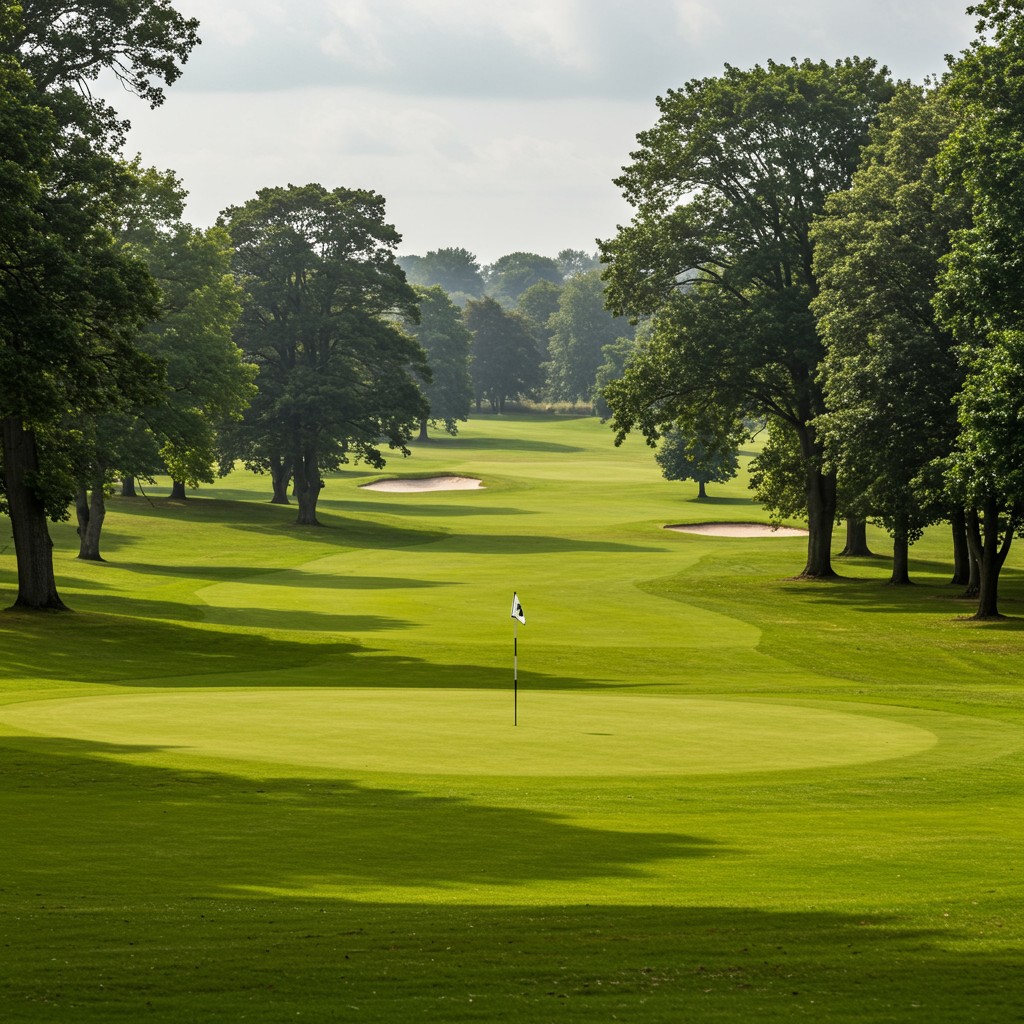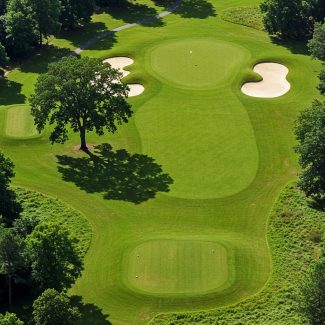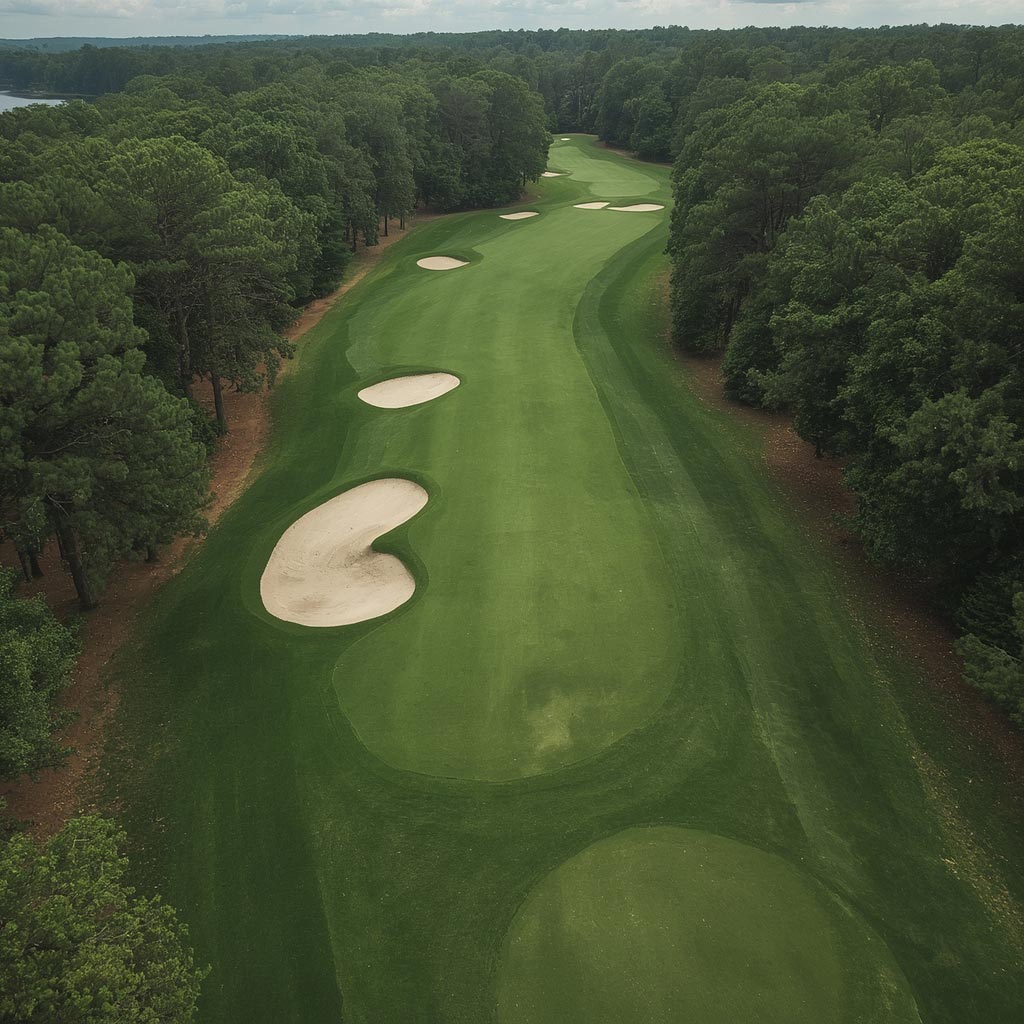
A Legacy of Parkland Golf: The History & Vision of GCI Parklands Golf Course
Inspiration & Design Philosophy
GCI Parklands is a testament to the quintessential English parkland style, a course deliberately crafted to fit the rich, rolling terrain of central United Kingdom. While the origins of golf trace back to the links of coastal Scotland, the parkland aesthetic emerged in the late 19th century as the game moved inland, finding its home in serene, wooded estates. The design philosophy behind GCI Parklands honors this tradition, drawing deep inspiration from regional precedents that have defined the style, such as the storied layouts at The Belfry and Woburn.
The design is rooted in the principle that strategy and accuracy should be rewarded over brute force. It is not an open, wind-swept course where the ball runs out unpredictably, but a lush, meticulously manicured environment where every shot must be thoughtfully considered. The primary features of this course are its verdant, tree-lined fairways, which are framed by a variety of mature trees, including ancient oaks, towering pines, and elegant silver birches, echoing the stunning landscapes of Woburn. These natural obstacles dictate the strategic lines of play, making a precise drive a fundamental requirement for success.
Parklands Style

In contrast to the natural, often irregular terrain of links or heathland courses, GCI Parklands relies on a strategic arrangement of man-made hazards to create its challenge. Water hazards, streams, and a clever network of bunkers have been carefully integrated into the layout to punish errant shots and protect greens. The course is built on the characteristic clay-rich, loamy soil of the region, which is excellent for growing the lush turf that gives the course its carpet-smooth fairways and greens. This foundation, however, required the implementation of a state-of-the-art drainage system to ensure year-round playability, a crucial consideration for any course built on clay. This design philosophy ensures that GCI Parklands is a “thinking golfer’s course,” providing an enjoyable yet testing experience for players of all abilities.
Course History

The vision for GCI Parklands was born in the late 20th century, a time when the game of golf was rapidly expanding and new courses were being built at a furious pace. A group of local landowners and enthusiasts, concerned that the classic English parkland style might be lost to modern, less integrated designs, sought to create a course that felt as though it had always been a part of the landscape. They acquired a tract of gently rolling countryside, a landscape punctuated by ancient woodlands and framed by historic hedgerows, and commissioned a design that would respect the natural contours of the land.
The design and construction process was a meticulous affair. Architects worked closely with a team of arborists to carefully integrate the course into the existing, mature woodlands, minimizing the removal of trees and maximizing their use as strategic features. This was a deliberate choice to retain the course’s natural character and avoid the feeling of being carved out of a forest. The designers faced the unique challenge of working with the region’s clay-rich soil, which, while ideal for growing turf, can present drainage issues. The solution was an advanced sub-surface drainage network, a significant engineering feat that ensured the course would be firm and playable even after heavy rains.
This careful approach to design and construction created a course that is both a natural extension of its environment and a strategic masterpiece. The name, GCI Parklands Golf Course, was chosen to reflect both its geographical location and its commitment to the classic parkland tradition. The course officially opened to the public in the early 21st century, immediately establishing itself as a premier destination for those seeking a tranquil escape and a strategic challenge.
GCI Parklands: Course Specifications and Playability
The Course At A Glance

Overall Course Metrics

GCI Parklands is an 18-hole, Par 72 championship course, a layout considered a benchmark for high-level play. The design is balanced to provide a variety of challenges, featuring a classic distribution of four Par 3s, ten Par 4s, and four Par 5s. The course offers a range of total yardages from four distinct tee boxes, catering to players of different skill levels. The total yardages for each tee are carefully calibrated to provide a comprehensive test for their designated players, ranging from the forward tees designed for a more enjoyable round to the championship tees for professional competition.
- Black Tees (Championship): Approximately 7,100 yards
- White Tees (Men’s Medal): Approximately 6,600 yards
- Yellow Tees (Men’s & Ladies’ Standard): Approximately 6,100 yards
- Red Tees (Ladies’ Forward): Approximately 5,200 yards
The tee boxes are designated for Men’s and Ladies’ play to ensure fair and competitive rounds. The Black, White, and Yellow tees are designated for Men, while the Red and Yellow tees are available for Ladies. This provides an optimal playing experience for all golfers, allowing them to choose a set of tees that aligns with their skill level and desired challenge.
The World Handicap System at GCI Parklands
The playability of GCI Parklands is meticulously documented using the World Handicap System (WHS) methodology, which provides an objective measure of a course’s difficulty for players of varying abilities. This system relies on two key metrics: the Course Rating and the Slope Rating.
The Course Rating is an evaluation of the course’s playing difficulty for a scratch golfer—a player with a Handicap Index of 0.0 who can typically hit a tee shot around 250 yards. The rating is expressed as the number of strokes a scratch golfer is expected to take under normal course and weather conditions. It is a figure that is largely determined by the effective playing length of the course, which accounts for factors such as elevation changes, doglegs, and roll.
The Slope Rating, on the other hand, is a crucial metric for understanding how much more difficult a course is for a non-scratch player compared to a scratch golfer. A course of standard relative difficulty has a Slope Rating of 113, with values ranging from 55 to 155. The value is calculated from the difference between the Course Rating and the Bogey Rating, which is the expected score for a bogey player (a player with a Handicap Index of approximately 20 for men or 24 for women). A higher Slope Rating indicates that the course’s obstacles and design disproportionately increase the scores of higher-handicap players.
Design for Slope & Rating

The design of GCI Parklands, with its tight, tree-lined fairways and strategic hazards, inherently leads to a higher-than-average Slope Rating. The strategic nature of the course means that a scratch golfer can often carry a fairway bunker or navigate a dogleg with precision, minimizing the impact of these obstacles on their score. Conversely, a bogey player, who does not have the same length or accuracy, is more likely to be forced into a difficult lay-up, get caught behind a tree, or find their ball in one of the course’s deep bunkers. The cumulative effect of these challenges increases the Bogey Rating significantly more than the Course Rating, resulting in a higher overall Slope Rating. This correlation between the course’s parkland style and its WHS ratings confirms that GCI Parklands is a true test of strategic golf for players of all skill levels.
The calculated Course and Slope Ratings for GCI Parklands are as follows:
Table 2.1: GCI Parklands Tee Box Ratings
| Tee Color | Gender | Par | Total Yardage | Course Rating | Slope Rating |
|---|---|---|---|---|---|
| Black | Men’s | 72 | 7,125 | 74.8 | 138 |
| White | Men’s | 72 | 6,610 | 72.1 | 132 |
| Yellow | Men’s | 72 | 6,095 | 69.5 | 125 |
| Yellow | Ladies’ | 72 | 6,095 | 76.2 | 141 |
| Red | Ladies’ | 72 | 5,215 | 70.8 | 129 |
The GCI Parklands Golf Course Scorecard
The official scorecard for GCI Parklands provides a comprehensive overview of the course’s layout and strategic design. It serves as a vital tool for players, providing all the necessary information for a fair and accurate round under the World Handicap System. Beyond simply listing yardages, the scorecard’s stroke index (handicap) allocation is a reflection of the course’s nuanced difficulty. The distribution of the handicap is not based on length alone but on a careful evaluation of each hole’s overall challenge, including factors like strategic hazards, elevation changes, and the demands of the green complex.
A hole where “a par here feels like a birdie!” is a prime candidate for a low stroke index. This is because a long, straightforward Par 5 might be an easier hole for a high-handicapper to manage than a short, treacherous Par 4 that demands a precise tee shot and a delicate approach. The lowest stroke indices (1-18) are therefore assigned to the holes where a non-scratch player is most likely to need an extra stroke to compete fairly. On GCI Parklands, this often means the most difficult Par 4s, which are unforgiving of errant shots, are rated as the toughest holes on the course. This detailed approach makes the scorecard a strategic guide, not merely a record of distance.
Table 3.1: GCI Parklands Golf Course – Official Scorecard
| Hole | Par | Men’s Handicap | Red (Ladies’) Yards | Yellow (Men’s/Ladies’) Yards | White (Men’s) Yards | Black (Men’s) Yards |
|---|---|---|---|---|---|---|
| 1 | 4 | 9 | 320 | 385 | 405 | 425 |
| 2 | 4 | 15 | 305 | 370 | 385 | 400 |
| 3 | 5 | 11 | 425 | 475 | 510 | 545 |
| 4 | 3 | 3 | 165 | 200 | 215 | 235 |
| 5 | 4 | 13 | 310 | 360 | 380 | 410 |
| 6 | 4 | 5 | 350 | 405 | 425 | 450 |
| 7 | 3 | 17 | 145 | 175 | 190 | 205 |
| 8 | 5 | 1 | 410 | 465 | 485 | 505 |
| 9 | 4 | 7 | 340 | 390 | 420 | 450 |
| Out | 36 | – | 2,770 | 3,225 | 3,415 | 3,625 |
| 10 | 4 | 18 | 290 | 335 | 355 | 385 |
| 11 | 5 | 4 | 430 | 480 | 510 | 535 |
| 12 | 3 | 16 | 125 | 145 | 160 | 180 |
| 13 | 4 | 6 | 365 | 410 | 430 | 460 |
| 14 | 4 | 10 | 330 | 380 | 405 | 430 |
| 15 | 5 | 14 | 400 | 450 | 490 | 525 |
| 16 | 4 | 2 | 415 | 460 | 490 | 515 |
| 17 | 3 | 12 | 155 | 180 | 195 | 210 |
| 18 | 4 | 8 | 330 | 390 | 410 | 440 |
| In | 36 | – | 2,840 | 3,230 | 3,405 | 3,600 |
| Total | 72 | – | 5,610 | 6,455 | 6,820 | 7,225 |
Become a Course Strategist on the GCI Parklands Golf Course
Get a complete hole-by-hole, shot-by-shot strategy guide for this course, personalized for your game, in one of our Course Strategist Strategy Guides
Hole-by-Hole Guide: A Strategic Tour of GCI Parklands
1: The Opener
| Par | Yards (Black) | Yards (White) | Yards (Yellow) | Yards (Red) | Handicap |
| 4 | 425 | 405 | 385 | 320 | 9 |
- Layout & Strategy: A gentle, welcoming Par 4 that doglegs slightly to the right. The hole is a classic opener, designed to encourage a confident tee shot but with enough strategic subtlety to demand attention. It’s a generous start, much like the opening hole at Woburn’s Marquess Course.
- Fairway: The fairway is wide and slopes imperceptibly from left to right and slightly uphill. It is framed on both sides by a collection of mature silver birch trees, creating a verdant channel that guides the eye toward the green.
- Hazards: A strategically placed fairway bunker is located on the right side of the landing area at approximately 280 yards from the Black tee, designed to catch an over-aggressive drive. A second, smaller bunker is positioned just short of the green on the right to collect approach shots that miss wide.
- Water: A pond guards the right side of the green, catching pushed or sliced approach shots.
- Green Complex: The green is large and relatively flat, with subtle undulations that reward a precise approach. A significant false front will repel any shot that comes up short, requiring players to carry their approach all the way onto the putting surface.
- Out-of-Bounds (OB): Out-of-bounds runs the entire length of the hole on the right side, defined by a historic stone wall that borders the property.
2: Old Oak
| Par | Yards (Black) | Yards (White) | Yards (Yellow) | Yards (Red) | Handicap |
| 4 | 400 | 385 | 370 | 305 | 15 |
- Layout & Strategy: A straightforward, medium-length Par 4. While not overtly difficult, the hole’s true challenge lies in the placement of a single, ancient oak tree that looms on the left side of the fairway, punishing any pull from the tee.
- Fairway: The fairway is wide and inviting, with a gentle slope from left to right, but any shot veering left will be blocked by the immense branches of the oak tree. The terrain is flat, with a slight uphill climb to the green. Rough on both sides is thick.
- Hazards: A pair of subtle bunkers guards the left side of the fairway at 250 yards from the Black tee, but the main obstacle is the colossal oak. The green is protected by a small, deep pot bunker on the left, a design element that mirrors the classic, subtle bunkering of courses like Little Aston.
- Green Complex: The green is small and slightly elevated, sloping from back to front. Its surface is immaculate, requiring a delicate touch with the putter.
- Out-of-Bounds (OB): There is no out-of-bounds on this hole.
3: The Gullies
| Par | Yards (Black) | Yards (White) | Yards (Yellow) | Yards (Red) | Handicap |
| 5 | 545 | 510 | 475 | 425 | 11 |
- Layout & Strategy: A challenging, sweeping Par 5 that plays from an elevated tee box down into a valley before rising again to the green. The hole is a gentle dogleg left that demands accuracy to set up a good second shot. The strategic purpose of the design is to tempt players to cut the corner while penalizing poor execution.
- Fairway: The fairway drops away from the tee and then narrows as it ascends toward the green. It is defined by a series of natural gullies that meander through the landing area.
- Hazards: A large, strategically placed bunker guards the inner corner of the dogleg at 290 yards from the Black tee, designed to catch an ambitious drive trying to shorten the hole. A second bunker is positioned short of the green to force a strategic lay-up or challenge a long approach shot.
- Green Complex: The green is elevated and well-protected, with a severe slope from back to front. It is a challenging putting surface where distance control is paramount.
- Out-of-Bounds (OB): A line of mature pine trees on the far-left side of the hole marks the boundary.
4: The Dell
| Par | Yards (Black) | Yards (White) | Yards (Yellow) | Yards (Red) | Handicap |
| 3 | 235 | 215 | 200 | 165 | 3 |
- Layout & Strategy: A long, demanding Par 3 that requires a forced carry over a natural dell. The hole is a pure test of long-iron or hybrid play, with a very shallow green that makes holding the putting surface a monumental task. The hole’s low handicap index is a testament to its difficulty for all players.
- Fairway: The “fairway” is essentially the dell, a low-lying, natural basin that collects balls that fall short of the green.
- Hazards: The dell is the primary hazard, with thick, un-manicured grass and a steep incline that makes a recovery shot nearly impossible. Two deep, revetted bunkers are positioned to the left and right of the green, serving as further punishment for errant tee shots.
- Green Complex: The green is narrow and undulating, with a significant slope from right to left that will sweep shots away from the pin if they are not struck with precision.
- Out-of-Bounds (OB): There is no out-of-bounds on this hole.
5: The Ridge
| Par | Yards (Black) | Yards (White) | Yards (Yellow) | Yards (Red) | Handicap |
| 4 | 410 | 380 | 360 | 310 | 13 |
- Layout & Strategy: A strategic Par 4 that plays across a pronounced ridge in the fairway. The tee shot must clear the ridge to allow a clear view of the green and a chance at a short approach.
- Fairway: The fairway ascends to a ridge approximately 270 yards from the Black tee before falling sharply toward the green. The terrain is undulating, with a subtle left-to-right slope.
- Hazards: A pair of bunkers flanks the ridge on the left and right, designed to catch drives that fail to carry the crest. A large, crescent-shaped bunker guards the entire front of the green, forcing players to commit to their approach shot.
- Green Complex: The green is large and multi-tiered, with a significant drop from the back to the front tier. Pin positions on the back tier are especially challenging, requiring an accurate shot to avoid a difficult two-putt.
- Out-of-Bounds (OB): Out-of-bounds runs along the right side of the hole, defined by the white posts of the adjacent property.
6: The Long Meadow
| Par | Yards (Black) | Yards (White) | Yards (Yellow) | Yards (Red) | Handicap |
| 4 | 450 | 425 | 405 | 350 | 5 |
- Layout & Strategy: A long, uphill Par 4 that feels like a Par 5 for most players, a challenging hole where “a par here feels like a birdie”. It requires two long, accurate shots to reach the green in regulation.
- Fairway: The fairway is wide but climbs steadily from tee to green. This significant elevation change adds at least 20-30 yards to the effective playing length, making it a true test of stamina and strength.
- Hazards: Two small but deep bunkers are located on the left side of the fairway at 260 yards from the Black tee, penalizing a miss with the driver. A large, well-placed bunker to the left of the green and a subtle run-off area to the right protect the putting surface.
- Green Complex: The green is large, with subtle, challenging contours and a slight back-to-front slope. The surface is meticulously maintained to be lightning fast, demanding careful speed control.
- Out-of-Bounds (OB): There is no out-of-bounds on this hole.
7: The Pond
| Par | Yards (Black) | Yards (White) | Yards (Yellow) | Yards (Red) | Handicap |
| 3 | 205 | 190 | 175 | 145 | 17 |

- Layout & Strategy: A picturesque and strategic Par 3 that requires a forced carry over a large, man-made pond. The hole offers a generous green target, but the water creates a psychological challenge and punishes any shot that comes up short.
- Fairway: Not applicable, as this is a Par 3.
- Hazards: The primary hazard is the large pond that occupies the area between the tee box and the green. A long, deep bunker wraps around the left side of the green, and a run-off area on the right will repel any shot that misses long.
- Green Complex: The green is large and two-tiered, with a gentle slope toward the water hazard in front. It is designed to be receptive to a well-struck iron shot but will not hold an over-aggressive one.
- Out-of-Bounds (OB): Out-of-bounds is located behind the green, marked by a line of mature chestnut trees.
8: The Corner
| Par | Yards (Black) | Yards (White) | Yards (Yellow) | Yards (Red) | Handicap |
| 5 | 505 | 485 | 465 | 410 | 1 |

- Layout & Strategy: The hardest hole on the course. This long Par 5 is a challenging dogleg right that demands both length and accuracy from the tee. The strategic challenge is a sharp dogleg that can be cut, but at great risk, creating a true risk-reward scenario.
- Fairway: The fairway slopes from left to right, and a large stand of ancient oak trees guards the inside of the dogleg. An accurate tee shot must be hit down the left side to open up a clear second shot.
- Hazards: The mature oaks on the right are the primary hazard, forcing a long and straight drive. Two cunningly placed fairway bunkers are located at the corner of the dogleg, positioned to capture any overly ambitious tee shot trying to cut the corner. The green is protected by a pair of deep, classical bunkers on the left and right.
- Green Complex: The green is small and slightly elevated, with a subtle but treacherous slope from back to front. The putting surface is fast and true, but approach shots must be precise to avoid the run-off areas.
- Out-of-Bounds (OB): Out-of-bounds runs the entire length of the hole on the right side, defined by a dense copse of pine trees.
9: The Home Stretch
| Par | Yards (Black) | Yards (White) | Yards (Yellow) | Yards (Red) | Handicap |
| 4 | 450 | 420 | 390 | 340 | 7 |
- Layout & Strategy: A long, straight Par 4 that finishes the front nine. The hole offers a respite from the strategic demands of the previous holes, but its length makes it a significant challenge, especially for players who cannot hit a long drive.
- Fairway: The fairway is wide and generous, running straight from the tee to the green with a slight downhill slope. It is framed by a variety of mature deciduous trees on both sides.
- Hazards: A single fairway bunker on the right side at 275 yards from the Black tee is positioned to catch a slice. A deep, sod-faced bunker guards the left side of the green, while a large, flat bunker protects the front right.
- Green Complex: The green is large and undulating, with a significant swale in the center that makes certain pin positions difficult to access. It slopes gently from back to front.
- Out-of-Bounds (OB): There is no out-of-bounds on this hole.
10: The Transition
| Par | Yards (Black) | Yards (White) | Yards (Yellow) | Yards (Red) | Handicap |
| 4 | 385 | 355 | 335 | 290 | 18 |
- Layout & Strategy: A short, gentle Par 4 that serves as a breather before the challenging back nine. It is a straightforward, downhill hole that encourages an aggressive line off the tee to set up a short approach to the green.
- Fairway: The fairway is generous and slopes gently from tee to green. It is framed by a line of mature beech trees on the right and a stand of pine trees on the left.
- Hazards: A single, deep fairway bunker on the right side at 250 yards from the Black tee is positioned to catch an overly aggressive tee shot. The green is protected by two well-placed bunkers, one front-left and one back-right.
- Green Complex: The green is large, flat, and subtly undulating. It is designed to be receptive to a variety of approach shots, making it an excellent scoring opportunity.
- Out-of-Bounds (OB): There is no out-of-bounds on this hole.
11: The Serpent
| Par | Yards (Black) | Yards (White) | Yards (Yellow) | Yards (Red) | Handicap |
| 5 | 535 | 510 | 480 | 430 | 4 |
- Layout & Strategy: A long, winding Par 5 that doglegs left and then right around a large, man-made lake. The hole is a true three-shot par for most players, but a strong, accurate drive can tempt the bravest to go for the green in two, risking a watery grave.
- Fairway: The fairway snakes its way around the large, serpentine lake. The landing area is generous for the tee shot, but narrows considerably for the second shot as the water comes into play.
- Hazards: The large lake is the primary hazard, with water coming into play on the right for the first two shots and wrapping around the green on the left. A series of bunkers flanks the fairway in key lay-up areas, forcing players to choose their line with care.
- Green Complex: The green is protected on the left by the lake and on the right by a large, deep bunker. It is a subtly sloping putting surface that can be difficult to read.
- Out-of-Bounds (OB): There is no out-of-bounds on this hole.
12: The Quarry
| Par | Yards (Black) | Yards (White) | Yards (Yellow) | Yards (Red) | Handicap |
| 3 | 180 | 160 | 145 | 125 | 16 |
- Layout & Strategy: A short but intimidating Par 3 that requires a carry over a natural gully and a line of ancient, half-buried rocks. It is a visually stunning hole, framed by mature trees, and requires a delicate touch.
- Fairway: Not applicable, as this is a Par 3.
- Hazards: The natural gully and the rocky outcrop are the main hazards, creating a forced carry. A deep, well-placed bunker to the left of the green and a run-off area on the right will capture any errant shots.
- Green Complex: The green is small and elevated, with a severe slope from back to front. The surface is subtly undulating, and a shot that misses the target by even a small margin will not hold the putting surface.
- Out-of-Bounds (OB): There is no out-of-bounds on this hole.
13: The Valley
| Par | Yards (Black) | Yards (White) | Yards (Yellow) | Yards (Red) | Handicap |
| 4 | 460 | 430 | 410 | 365 | 6 |
- Layout & Strategy: A long, strategic Par 4 that is consistently ranked as one of the toughest holes on the course. It plays from a high tee box down into a valley before rising to an elevated green. An accurate drive is essential to provide a clear second shot.
- Fairway: The fairway is wide but slopes from right to left as it descends into the valley. A perfect tee shot will favor the right side of the fairway, which provides the best angle for an uphill approach.
- Hazards: A single bunker on the left side of the fairway is positioned to thwart a drive that favors the wrong side of the hole. A series of bunkers guards the front-right of the green, trapping any approach shot that is not struck with enough conviction.
- Green Complex: The green is elevated and well-protected by the surrounding topography. It is a large, undulating surface that slopes from back to front.
- Out-of-Bounds (OB): There is no out-of-bounds on this hole.
14: The Pines
| Par | Yards (Black) | Yards (White) | Yards (Yellow) | Yards (Red) | Handicap |
| 4 | 430 | 405 | 380 | 330 | 10 |
- Layout & Strategy: A medium-length Par 4 that requires a long, straight tee shot through a chute of mature pine trees. Accuracy is paramount on this hole, as a wayward drive will be blocked out by the dense, low-hanging pine branches.
- Fairway: The fairway is narrow and framed on both sides by a dense line of pine trees. It is flat and in excellent condition, offering a perfect lie for a well-placed drive.
- Hazards: The pine trees are the main hazard on this hole, creating a formidable barrier for any tee shot that misses the fairway. Two small, but deep, pot bunkers are located on the left and right of the green, guarding against errant approach shots.
- Green Complex: The green is large and firm, with a subtle left-to-right slope. The surface is renowned for its speed, demanding a delicate touch on every putt.
- Out-of-Bounds (OB): A dense line of trees on the right side of the hole marks the out-of-bounds.
15: The Dell
| Par | Yards (Black) | Yards (White) | Yards (Yellow) | Yards (Red) | Handicap |
| 5 | 525 | 490 | 450 | 400 | 14 |
- Layout & Strategy: A strategic Par 5 that offers a clear risk-reward opportunity. The hole plays downhill from the tee, tempting long hitters to go for the green in two. However, a strategically placed stream and a series of bunkers create a significant barrier for the over-aggressive shot.
- Fairway: The fairway is wide and runs downhill before ascending to the green. A natural stream meanders across the fairway at 290 yards from the Black tee, creating a forced lay-up for many players.
- Hazards: The stream is the main hazard, and it must be carried or laid up short of. A series of bunkers flanks the stream on both sides, punishing a poor tee shot. The green is protected by a pair of deep bunkers on the left and right.
- Green Complex: The green is elevated and slopes from back to front. It has a significant false front that will reject any short approach shot.
- Out-of-Bounds (OB): Out-of-bounds runs along the right side of the hole, defined by a line of white stakes.
16: The Uphill Finisher
| Par | Yards (Black) | Yards (White) | Yards (Yellow) | Yards (Red) | Handicap |
| 4 | 515 | 490 | 460 | 415 | 2 |
- Layout & Strategy: A brutal, uphill Par 4 that plays like a Par 5 for most. The hole is a pure test of endurance and is the second-most difficult hole on the course. A long, accurate drive is essential, but the true challenge is the long, uphill second shot to the green.
- Fairway: The fairway is wide but climbs unrelentingly from tee to green. This massive elevation change adds a significant amount of effective playing length to an already long hole.
- Hazards: A single, large bunker is positioned on the right side of the fairway at the top of a rise, designed to punish a faded tee shot. The green is protected by two deep bunkers on the left and right that are positioned to capture any approach shot that misses the target.
- Green Complex: The green is large and elevated, with a subtle but treacherous slope that can make certain putts difficult to read. The surface is perfectly manicured and fast, demanding careful speed control.
- Out-of-Bounds (OB): There is no out-of-bounds on this hole.
17: The Island Green
| Par | Yards (Black) | Yards (White) | Yards (Yellow) | Yards (Red) | Handicap |
| 3 | 210 | 195 | 180 | 155 | 12 |
- Layout & Strategy: A thrilling Par 3 that requires a forced carry over a large, man-made pond to an island green. This hole is a signature feature of the course and provides a dramatic penultimate challenge.
- Fairway: Not applicable, as this is a Par 3.
- Hazards: The entire area between the tee and the green is occupied by the man-made pond. A series of deep bunkers are located behind the green to punish a long tee shot. A large, flat bunker is also located in front of the green.
- Green Complex: The green is large and undulating, with a significant slope from back to front. The putting surface is meticulously maintained and is known for its speed and challenging contours.
- Out-of-Bounds (OB): There is no out-of-bounds on this hole.
18: The Home Hole
| Par | Yards (Black) | Yards (White) | Yards (Yellow) | Yards (Red) | Handicap |
| 4 | 440 | 410 | 390 | 330 | 8 |
- Layout & Strategy: A long, demanding Par 4 that is a classic finishing hole. It doglegs gently to the left, with the fairway framed by a large stand of mature chestnut trees. An accurate tee shot is essential to avoid being blocked out from the green.
- Fairway: The fairway is wide but slopes from right to left toward a line of bunkers and a dense copse of trees. The best line off the tee is down the right side, which provides the best angle for the approach shot.
- Hazards: A pair of large bunkers guards the inner corner of the dogleg, positioned to capture a hooked tee shot. A large, crescent-shaped bunker wraps around the front of the green, trapping any approach shot that comes up short.
- Green Complex: The green is large and two-tiered, with a significant slope from back to front. The putting surface is fast and true, and a three-putt is a distinct possibility if the ball is on the wrong tier.
- Out-of-Bounds (OB): Out-of-bounds runs along the entire length of the hole on the left, marked by a stone wall that borders the property.

Conclusions
GCI Parklands is a meticulously designed golf course that serves as a blueprint for the quintessential central UK parkland experience. The course is not merely a collection of holes but a cohesive and strategically challenging layout.
The design philosophy, inspired by the regional identity of courses in Warwickshire and Northamptonshire, has resulted in a course where accuracy and strategic play are paramount. This focus on precision is what fundamentally differentiates a parkland course from a links or heathland course, and it is a defining characteristic of GCI Parklands.
The analysis of the course’s WHS ratings provides a clear correlation between the course’s design elements and its difficulty. The high Slope Rating for all tee boxes is a direct result of the man-made hazards, tight fairways, and challenging green complexes that disproportionately impact the scores of higher-handicap players. This confirms that the course offers a fair and calibrated test for golfers of all abilities. The meticulous scorecard, with its thoughtfully assigned stroke indices, further ensures that competition among players of different skill levels remains equitable.
In its entirety, GCI Parklands stands as a professional-grade blueprint for a golf course that is both a strategic masterpiece and a beautiful, tranquil escape. The design choices, from the tree-lined fairways to the specific placement of hazards, are all intentionally linked to provide a nuanced and engaging experience that honors the classic English parkland tradition.
0 Comments